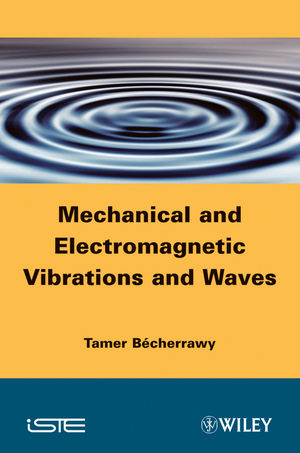
Mechanical and Electromagnetic Vibrations and Waves
ISTE Ltd and John Wiley & Sons Inc (Verlag)
9781848212831 (ISBN)
- Titel z.Zt. nicht lieferbar
- Versandkostenfrei
- Auch auf Rechnung
- Artikel merken
The content includes the general properties of propagation, a detailed study of mechanical (elastic and acoustic) and electromagnetic waves, propagation, attenuation, dispersion, reflection, interference and diffraction of waves.
It features chapters on the effect of motion of sources and observers (both classical and relativistic), emission of electromagnetic waves, standing and guided waves and a final chapter on de Broglie waves constitutes an introduction to quantum mechanics.
Tamer Becherrawy received the Doctorat 3e Cycle from the University of Paris and a PhD in Theoretical Physics from the University of Rochester, New York. He has taught Physics at the Faculty of Science of the Lebanese University in Beirut (Lebanon), the University of Savoy in Chambery, the IUFM and the University of Nancy (France). He was head of the Physics Department at the Lebanese University. He has published a number of research articles on High Energy Particle Physics.
Preface xi
Chapter 1. Free Oscillations1
1.1. Oscillations and waves, period and frequency 1
1.2. Simple harmonic vibrations: differential equation and linearity 2
1.3. Complex representation and phasor representation 5
1.4. Point mass subject to a force–Kx 9
1.5. Angular oscillations 12
1.6. Damped oscillations 15
1.7. Dissipation of the energy of a damped oscillator 19
1.8. Oscillating LCR circuits 20
1.9. Small oscillations of a system with one degree of freedom 22
1.10. Nonlinear oscillators 25
1.11. Systems with two degrees of freedom 25
1.12. Generalization to systems with n degrees of freedom 29
1.13. Normal variables for systems with n degrees of freedom* 32
1.14. Summary 35
1.15. Problem solving suggestions 38
1.16. Conceptual questions 39
1.17. Problems 40
Chapter 2. Superposition of Harmonic Oscillations, Fourier Analysis 51
2.1. Superposition of two scalar and isochronous simple harmonic oscillations 51
2.2. Superposition of two perpendicular and isochronous vector oscillations, polarization 53
2.3. Superposition of two perpendicular and non-isochronous oscillations 57
2.4. Superposition of scalar non-synchronous harmonic oscillations, beats 58
2.5. Fourier analysis of a periodic function 60
2.6. Fourier analysis of a non-periodic function 65
2.7. Fourier analysis of a signal, uncertainty relation 67
2.8. Dirac delta-function 69
2.9. Summary 71
2.10. Problem solving suggestions 74
2.11. Conceptual questions 75
2.12. Problems 76
Chapter 3. Forced Oscillations 83
3.1. Transient regime and steady regime 83
3.2. Case of a simple harmonic excitation force 85
3.3. Resonance 87
3.4. Impedance and energy of a forced oscillator in the steady regime 88
3.5. Complex impedance 92
3.6. Sustained electromagnetic oscillations 94
3.7. Excitation from a state of equilibrium* 96
3.8. Response to an arbitrary force, nonlinear systems 97
3.9. Excitation of a system of coupled oscillators 99
3.10. Generalization of the concepts of external force and impedance 103
3.11. Some applications 104
3.12. Summary 105
3.13. Problem solving suggestions 106
3.14. Conceptual questions 107
3.15. Problems 108
Chapter 4. Propagation in Infinite Media 115
4.1. Propagation of one-dimensional waves 115
4.2. Propagation of two- and three-dimensional waves 117
4.3. Propagation of a vector wave 121
4.4. Polarization of a transverse vector wave 123
4.5. Monochromatic wave, wave vector and wavelength125
4.6. Dispersion 127
4.7. Group velocity 129
4.8. Fourier analysis for waves* 130
4.9. Modulation 133
4.10. Energy of waves 135
4.11. Other unattenuated wave equations, conserved quantities* 137
4.12. Impedance of a medium* 139
4.13. Attenuated waves 140
4.14. Sources and observers in motion, the Doppler effect and shock waves 143
4.15. Summary 148
4.16. Problem solving suggestions 150
4.17. Conceptual questions 152
4.18. Problems 153
Chapter 5. Mechanical Waves 159
5.1. Transverse waves on a taut string 159
5.2. Strain and stress in elastic solids 162
5.3. Elastic waves in massive springs and rods 166
5.4. Propagation of sound in a pipe 168
5.5. Transverse waves on elastic membranes 172
5.6. Mechanical waves in three dimensions 174
5.7. Energy of mechanical waves 176
5.8. Progressive waves, impedance and intensity 179
5.9. Elements of physiological acoustics 183
5.10. Infrasounds and ultrasounds 185
5.11. Surface waves* 186
5.12. Summary 191
5.13. Problem solving suggestions 194
5.14. Conceptual questions 194
5.15. Problems 195
Chapter 6. Electromagnetic Waves 201
6.1. Principal results of the electromagnetic theory 201
6.2. The propagation equations of the fields in vacuum and infinite dielectrics 204
6.3. Electromagnetic simple harmonic plane waves 205
6.4. Energy density and the Poynting vector 206
6.5. Polarization of electromagnetic waves 207
6.6. Momentum density and angular momentum density, radiation pressure* 209
6.7. Electromagnetic waves in plasmas* 212
6.8. Electromagnetic waves in Ohmic conductors* 214
6.9. Quantization of electromagnetic radiation 218
6.10. Electromagnetic spectrum 219
6.11. Emission of electromagnetic radiations 221
6.12. Spontaneous emission and stimulated emission 223
6.13. Summary 226
6.14. Problem solving suggestions 229
6.15. Conceptual questions 229
6.16. Problems 231
Chapter 7. Reflection and Refraction of Waves 237
7.1. Reflection of an elastic wave on two joined strings 237
7.2. Reflection and transmission of a one-dimensional acoustic wave 240
7.3. General laws of reflection and transmission of three-dimensional waves 243
7.4. Reflection and refraction of a three-dimensional acoustic wave 246
7.5. Reflection and refraction of an electromagnetic wave at the interface of dielectrics 248
7.6. Case of attenuated waves in the second medium* 255
7.7. Summary 258
7.8. Problem solving suggestions 260
7.9. Conceptual questions 261
7.10. Problems 262
Chapter 8. Interference and Diffraction 269
8.1. Order and fringes of interference of two waves 269
8.2. Intensity and contrast 271
8.3. Interference of light waves, Young’s experiment 273
8.4. Multiwave interference, conditions for interference 277
8.5. Holography 281
8.6. Thin film interference 282
8.7. The Huygens-Fresnel principle and diffraction by an aperture 285
8.8. Diffraction grating 290
8.9. Diffraction of X-rays 295
8.10. Summary 297
8.11. Problem solving suggestions 299
8.12. Conceptual questions 300
8.13. Problems 301
Chapter 9. Standing Waves and Guided Waves 307
9.1. One-dimensional standing waves 308
9.2. Standing waves on a membrane and in a rectangular cavity 313
9.3. Fourier analysis of standing waves* 316
9.4. Resonance and standing waves 319
9.5. Sound wave guided by two parallel plates 320
9.6. Guided sound waves in a rectangular pipe 322
9.7. Transmission lines 324
9.8. Electromagnetic waveguides* 326
9.9. Waveguides formed by two plane and parallel plates* 328
9.10. Guided electromagnetic waves in a hollow conductor* 331
9.11. Applications of waveguides 335
9.12. Summary 337
9.13. Problem solving suggestions 340
9.14. Conceptual questions 341
9.15. Problems 342
Answers to the Problems 349
APPENDICES 371
Appendix A. Mathematical Review 373
A.1. Expansion formulas 373
A.2. Logarithmic, exponential and hyperbolic functions 374
A.3. Trigonometric functions 374
A.4. Integrals 375
A.5. Complex numbers 378
A.6. Vector analysis in Cartesian coordinates 380
A.7. Vector analysis in curvilinear coordinates 382
Appendix B. Units in Physics 387
B.1. Multiples and submultiples of units 387
B.2. Fundamental and derived SI units 387
B.3. Mechanical units 388
B.4. Electromagnetic units 389
Appendix C. Some Physical Constants 391
C.1. Mechanical and thermodynamic constants 391
C.2. Electromagnetic and atomic constants 392
Further Reading 393
Index 395
| Verlagsort | London |
|---|---|
| Sprache | englisch |
| Maße | 163 x 241 mm |
| Gewicht | 744 g |
| Themenwelt | Naturwissenschaften ► Physik / Astronomie ► Mechanik |
| ISBN-13 | 9781848212831 / 9781848212831 |
| Zustand | Neuware |
| Informationen gemäß Produktsicherheitsverordnung (GPSR) | |
| Haben Sie eine Frage zum Produkt? |
aus dem Bereich


